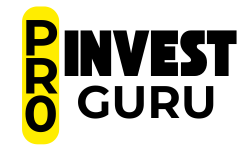Copywriting for Beginners: Learn & Making Money Online Fast
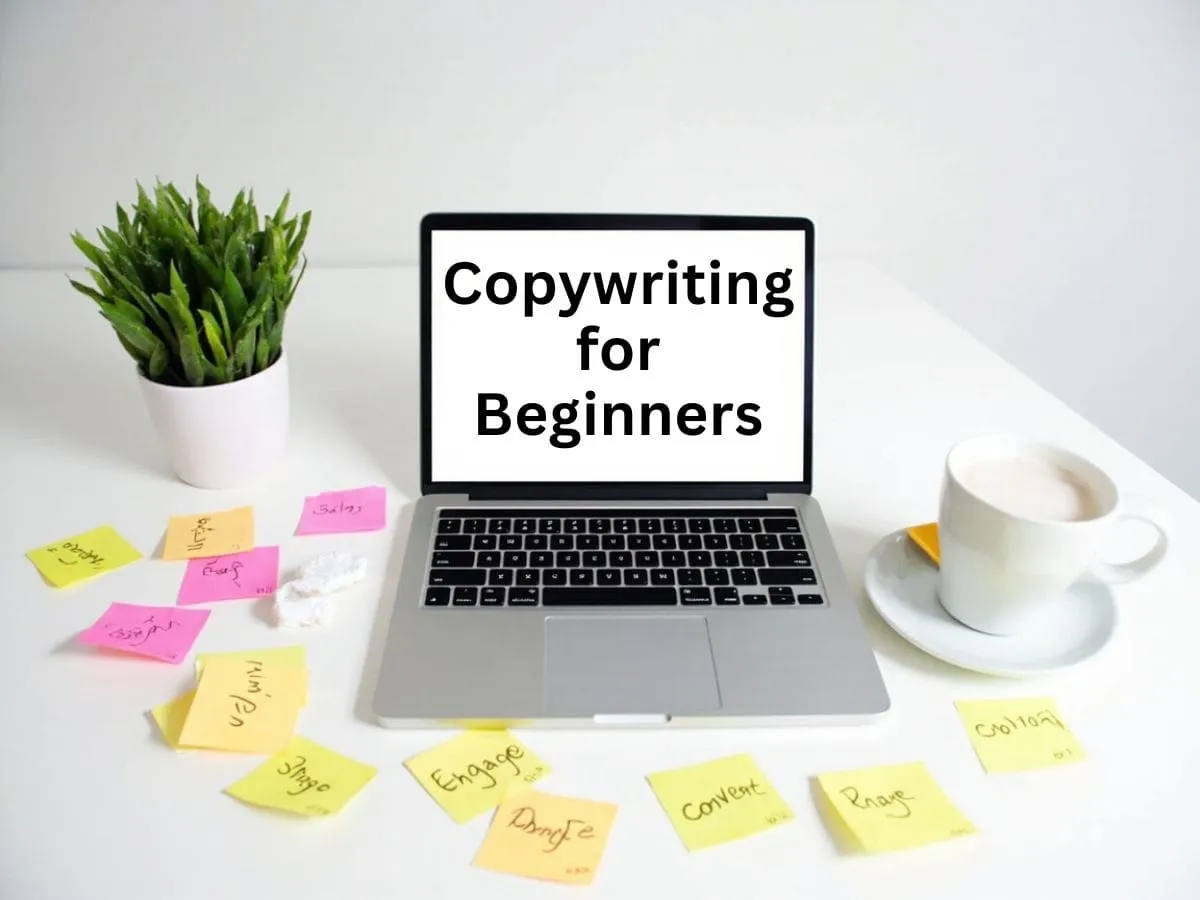
Copywriting has quickly become one of the most in-demand online skills in today’s digital world. Every business, whether it’s a startup or a large corporation, needs compelling words to attract customers, generate sales, and build brand authority. That’s where copywriters come in.
The best part? You don’t need a fancy degree or years of experience to get started. With the right guidance, anyone can learn copywriting and start making money online even as a complete beginner.
Copywriting for beginners is all about understanding what copywriting really means, why it’s such a powerful skill, how to master the basics, and the steps you can take to start making money online quickly.
What is Copywriting?
Copywriting is the art of writing persuasive text for marketing and sales purposes. Unlike regular writing, which may focus on storytelling or education, copywriting is designed to make readers take action whether that’s buying a product, subscribing to a newsletter, or signing up for a free trial.
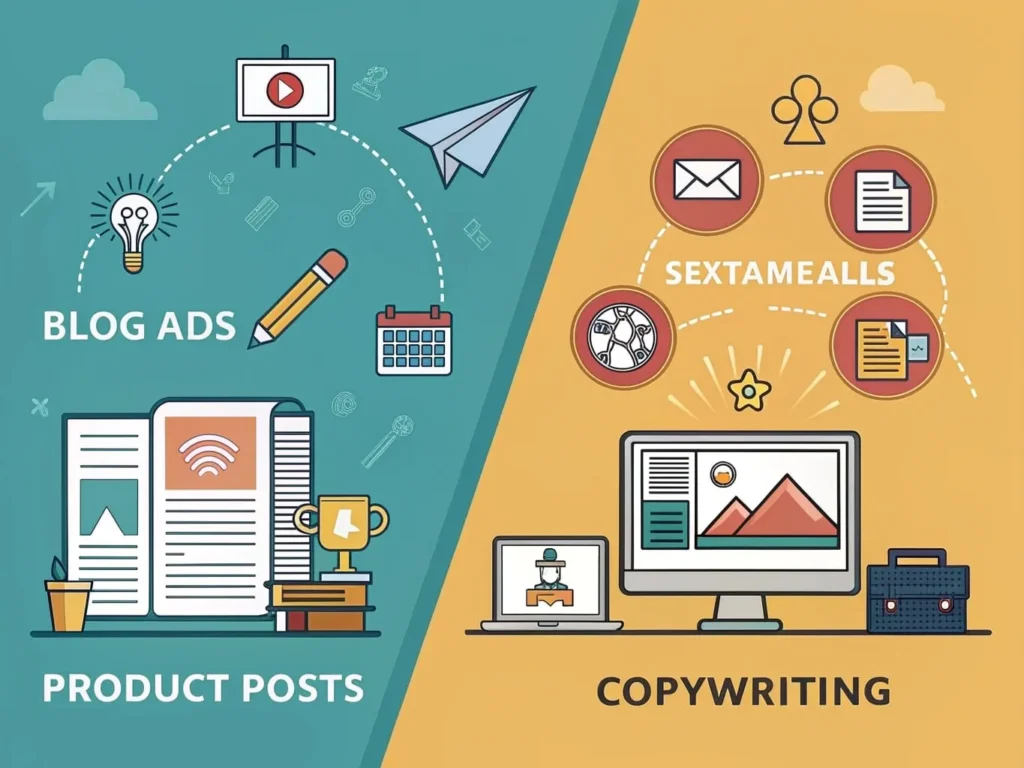
Examples of copywriting include:
- Website sales pages
- Social media ads
- Email campaigns
- Product descriptions
- Landing pages
In simple words, copywriting is salesmanship in writing.
Why Copywriting is Perfect for Beginners
If you’re just starting out online and looking for a skill to monetize quickly, copywriting is one of the best options. Here’s why:

- High Demand: Every business online needs copy.
- Low Investment: You only need a laptop and internet connection.
- Fast Results: With practice, you can start earning within weeks.
- Flexible work – freelance, part-time, or full-time.
- Scalable income – beginners can earn $500/month, while pros earn $10,000+/month.
- Evergreen skill – AI may assist, but persuasive human-driven copy will always be valuable.
How Much Do Copywriters Earn?
Earnings vary depending on skill level and experience, but here’s a general breakdown:
| Experience Level | Average Rate per Project | Monthly Potential Income |
|---|---|---|
| Beginner (0–6 months) | $20 – $100 | $300 – $1,000 |
| Intermediate (6–12 mo) | $100 – $500 | $1,000 – $5,000 |
| Experienced (1+ years) | $500 – $2,000+ | $5,000 – $15,000+ |
Many top-level copywriters earn six figures annually. This is why copywriting is often referred to as one of the fastest ways to make money online with no upfront investment.
Types of Copywriting You Can Start With
Before diving in, beginners should understand the different types of copywriting to choose the best starting point:
| Type of Copywriting | What It Involves | Beginner Pay | Pro-Level Pay |
|---|---|---|---|
| Website Copywriting | Writing homepages, landing pages, and “About” pages | $100–$300/page | $1,000+/page |
| Email Marketing | Writing email campaigns, newsletters, promotions | $50–$150/email | $500+/email |
| Product Descriptions | Short, persuasive product listings for e-commerce | $5–$15/product | $50+/product |
| Social Media Ads | Writing Facebook, Instagram, TikTok ads | $50–$200/ad | $500+/ad |
| Sales Pages | Long-form persuasive sales copy for products/courses | $200–$500/page | $2,000–$10,000/page |
Pro Tip: Start small with product descriptions or social media ads to build confidence, then move into higher-paying work like sales pages and email campaigns.
Step 1: Learn the Basics of Copywriting
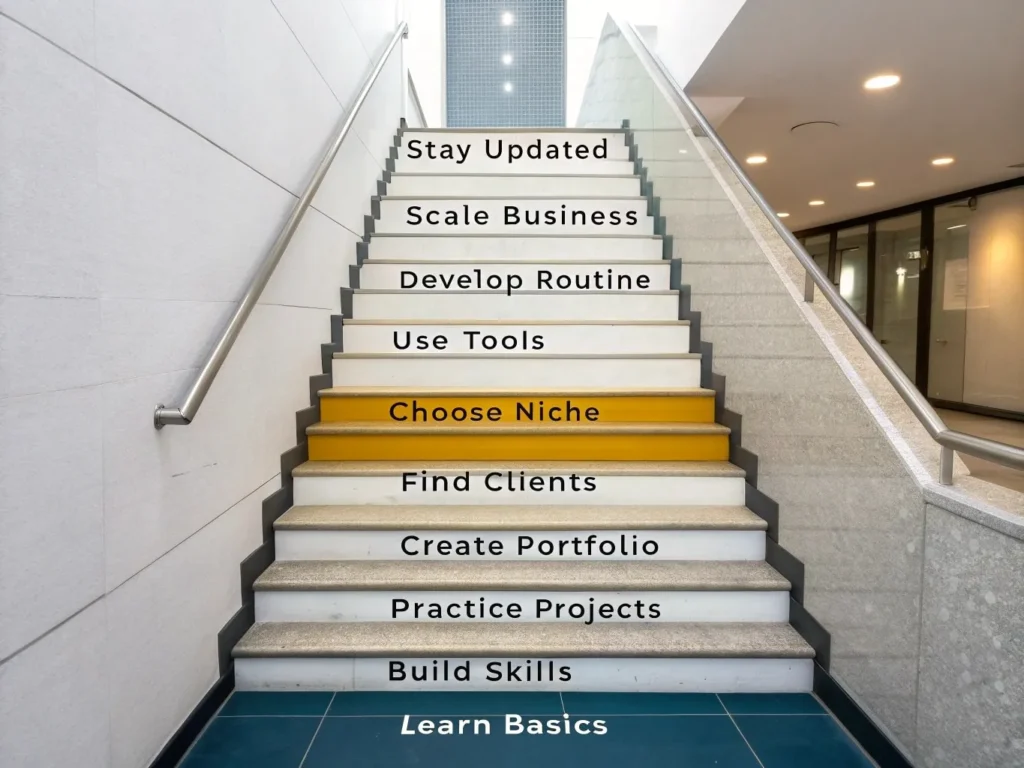
Before you start landing clients, you need to understand the fundamentals. Key principles include:
- AIDA Formula: Attention, Interest, Desire, Action
- Understanding Your Audience: Know their pain points, desires, and goals.
- Benefits Over Features: Don’t just describe a product—explain how it improves lives.
- Clarity and Simplicity: Simple, powerful language converts better than jargon.
Pro Tip: Read great copy daily. Ads, emails, landing pages—dissect them and see how they persuade.
Step 2: Build Essential Skills
Copywriting requires practice. As a beginner, focus on these skills:
- Writing Clarity: Write short, punchy sentences.
- Persuasion: Learn emotional triggers (fear, curiosity, urgency, desire).
- Research: Great copy comes from understanding the market and customer.
- SEO Basics: Knowing how to write search-friendly content gives you an edge.
Recommended free resources for beginners:
- Copyblogger blog
- HubSpot Academy (free courses)
- YouTube channels like Alex Cattoni & Neville Medhora
Step 3: Practice with Free Projects
You don’t need paying clients right away to practice. Instead, try:
- Rewriting product descriptions on Amazon for practice.
- Creating mock social media ads for brands.
- Writing email campaigns for imaginary products.
Save your best samples. These will become your portfolio.
Step 4: Build a Copywriting Portfolio
Clients want to see proof that you can write persuasive copy. A simple portfolio is enough:
- 3–5 sample projects (ads, landing pages, emails).
- A clean Google Docs or Canva PDF presentation.
- Optional: A free website using WordPress or Carrd.
Step 5: Find Your First Clients
Now it’s time to get paid. Here’s where beginners find work:
- Freelance platforms: Upwork, Fiverr, Freelancer.
- Job boards: ProBlogger, We Work Remotely, PeoplePerHour.
- Cold pitching: Reach out directly to small businesses.
- Networking: Post your skills on LinkedIn and Facebook groups.
Start small (charging $20–$50 per project), then increase rates as you gain testimonials.
Step 6: Learn Copywriting Niches
The fastest way to grow is to specialize. Some of the most profitable niches include:
- E-commerce product descriptions
- Email marketing
- Sales landing pages
- Social media ads
- B2B SaaS (software as a service)
Specialized copywriters often earn 2–3x more than generalists.
Step 7: Use Copywriting Tools
You don’t need expensive tools as a beginner, but these free/affordable options help:
- Grammarly – Grammar and tone correction.
- Hemingway Editor – Simplifies sentences.
- Canva – For creating simple ad mockups.
- Google Docs – Clean writing and easy sharing.
- ChatGPT – For brainstorming ideas and first drafts.
Step 8: Develop a Copywriting Routine
Success in copywriting comes from consistency. Here’s a routine beginners can follow:
- Write daily: Even 30 minutes improves your skill.
- Read ads: Collect and study persuasive ads.
- Analyze results: Learn what works by testing your copy.
Step 9: Scale Your Copywriting Business
Once you land a few clients, think long-term:
- Raise rates: Increase by 20–30% every few projects.
- Offer packages: For example, $500 for 5 emails instead of $100 per email.
- Build recurring clients: Monthly retainers for newsletters or social media ads.
Step 10: Stay Updated with Trends
Digital marketing evolves fast. New platforms, ad styles, and consumer behaviors emerge constantly.
Stay competitive by:
- Following copywriting influencers on LinkedIn.
- Taking advanced online courses (when you can invest).
- Experimenting with AI tools while keeping a human touch.
Copywriting Income Hierarchy
Here’s what you can expect to earn as a beginner vs. advanced copywriter:
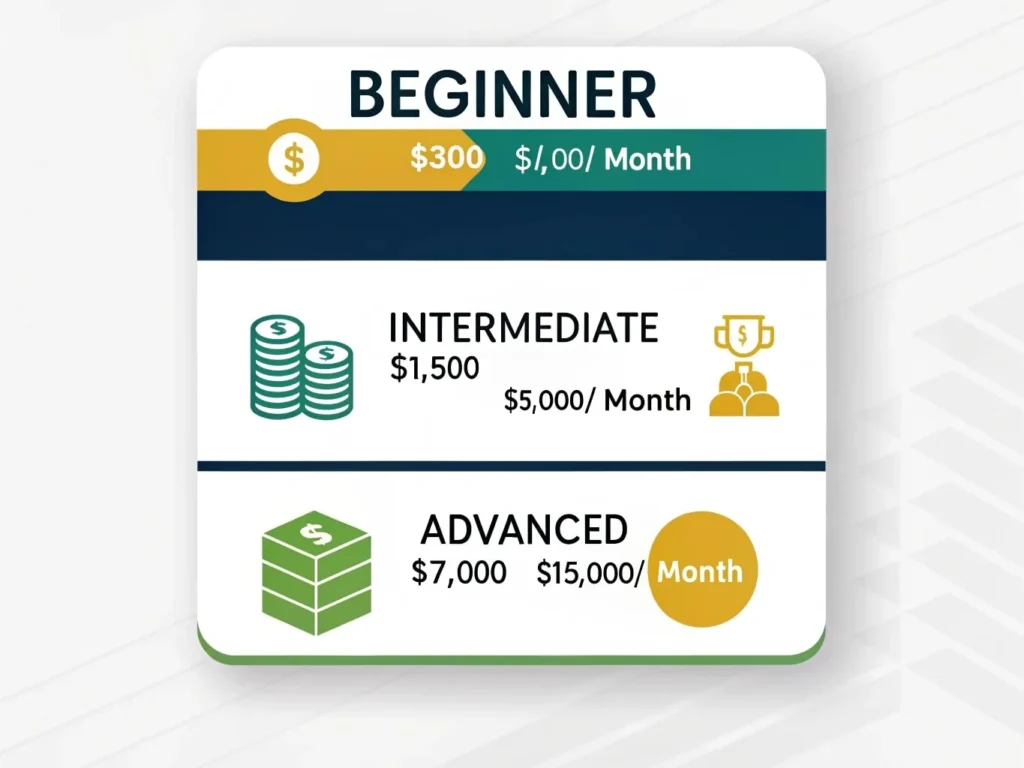
| Level | Experience | Average Monthly Income |
|---|---|---|
| Beginner | 0–6 months | $300 – $800 |
| Intermediate | 6–18 months | $1,500 – $5,000 |
| Advanced | 2+ years | $7,000 – $15,000 |
| Top Copywriters | Proven track record | $20,000+/month |
Case Study: From Beginner to Pro Copywriter
Emma, a college student, started freelancing on Fiverr in 2021. She offered $10 product descriptions and made $200 in her first month. By improving her portfolio and specializing in email marketing, she landed a client who paid her $1,500/month for ongoing work.
Two years later, Emma earns $8,000/month writing copy for e-commerce brands—all from her laptop at home.
Lesson: Start small, specialize, and scale.
Why Copywriting Beats Other Online Jobs
There are hundreds of online income methods, but copywriting stands out because of its scalability and long-term value.
| Method | Startup Cost | Scalability | Max Income Potential |
|---|---|---|---|
| Online Surveys | $0 | Very Low | $200/month |
| Data Entry | $0 | Low | $500–$1,000/month |
| Transcription | $0 | Medium | $1,500/month |
| Copywriting | $0 | Very High | $20,000+/month |
Copywriting doesn’t just pay more it builds a skill that compounds over time. The better you get, the higher your rates.
Tools Every Beginner Copywriter Should Use
- Grammarly – Grammar & spelling correction.
- Hemingway Editor – Improves readability.
- Canva – Design mockups for ads/emails.
- Trello / Notion – Project management.
- Google Docs – Client-friendly writing & editing.
Common Mistakes Beginners Should Avoid

- Writing too much fluff (shorter is often better).
- Focusing on features instead of customer benefits.
- Undercharging for quality work.
- Not building a portfolio early.
- Giving up too soon—copywriting takes time to master.
Conclusion
Copywriting for beginners isn’t just a side hustle—it can be the foundation of a highly profitable online career. With zero investment, just your laptop and internet, you can start practicing, building a portfolio, and finding clients within weeks.
The key is to start small, stay consistent, and keep learning. Your first $100 will motivate you, and soon, you could be earning thousands per month with this powerful digital skill.
So, if you’ve been searching for a proven way to make money online fast, copywriting is the path worth taking.
Frequently Asked Questions (FAQs)
1. Do I need a degree to become a copywriter?
No. Copywriting is a skill-based career. Clients care about results, not diplomas.
2. How much can a beginner copywriter earn?
Beginners typically earn $300–$1,000 per month, but with growth and experience, earnings can reach $5,000–$10,000+.
3. What is the difference between copywriting and content writing?
Content writing informs or educates, while copywriting persuades readers to take action (buy, sign up, etc.).
4. Can I start copywriting with no experience?
Yes. You can practice with mock projects and use them as portfolio samples to land your first clients.
5. What’s the fastest way to learn copywriting?
Study successful ads, practice daily, and start small freelance projects. Learning by doing is the fastest path.
